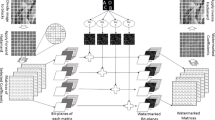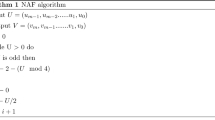Abstract
Ownership identification and copyright protection are two major concerns for digital data. Digital watermarking provides the best solution for these issues. In order to preserve the copyright protection and identify the ownership of digital data, a robust blind watermarking method using Bhattacharyya distance and exponential function is proposed. The proposed method is adaptive since the embedding factor is calculated based on the gray scale pixel distribution of the host image. Insertion of watermark is done in two phases in which the first phase is carried out in wavelet domain, and the second phase in spatial domain. Similarly extraction of watermark is done in two phases. The proposed method is tested using standard benchmark color images and a binary watermark. The proposed method is analyzed with various image and signal processing attacks and compared with other methods. The results show that the proposed method has better performance than other methods.



















Similar content being viewed by others
References
Abdallah H A, Ghazy R A, Kasban H, Faragallah O S, Shaalan A A, Hadhoud M M, Dessouky M I, El-Fishawy N A, Alshebeili S A, El-samie F E A (2014) Homomorphic image watermarking with a singular value decomposition algorithm. Inf Process Manag 50(6):909–923
Bhattacharyya A (1946) On a measure of divergence between two multinomial populations. Sankhyā: Ind J Stat:401–406
Busch C, Funk W, Wolthusen S (1999) Digital watermarking: from concepts to real-time video applications. Technical report, DTIC Document
Chang C-C, Tsai P, Lin C-C (2005) Svd-based digital image watermarking scheme. Pattern Recog Lett 26(10):1577–1586
Choi E, Lee C (2003) Feature extraction based on the bhattacharyya distance. Pattern Recog 36(8):1703–1709
Fazlali H R, Samavi S, Karimi N, Shirani S (2016) Adaptive blind image watermarking using edge pixel concentration. Multimed Tools Appl:1–16
Hartung F, Kutter M (1999) Multimedia watermarking techniques. Proc IEEE 87(7):1079–1107
Horng S-J, Rosiyadi D, Li T, Takao T, Guo M, Khan MK (2013) A blind image copyright protection scheme for e-government. J Vis Commun Image Represent 24(7):1099–1105
Hsu L-Y, Hwai-Tsu H (2015) Blind image watermarking via exploitation of inter-block prediction and visibility threshold in dct domain. J Vis Commun Image Represent 32:130–143
Huynh-Thu Q, Ghanbari M (2008) Scope of validity of psnr in image/video quality assessment. Electron Lett 44(13):800–801
Hwai-Tsu H, Hsu L-Y (2016) A mixed modulation scheme for blind image watermarking. AEU-Int J Electron Commun 70(2):172–178
Khotanzad A, Bouarfa A (1990) Image segmentation by a parallel, non-parametric histogram based clustering algorithm. Pattern Recogn 23(9):961–973
Prathap I, Natarajan V, Anitha R (2014) Hybrid robust watermarking for color images. Comput Electr Eng 40(3):920–930
Qingtang S, Niu Y, Zou H, Liu X (2013) A blind dual color images watermarking based on singular value decomposition. Appl Math Comput 219 (16):8455–8466
Qingtang S, Niu Y, Zhao Y, Pang S, Liu X (2013) A dual color images watermarking scheme based on the optimized compensation of singular value decomposition. AEU-Int J Electron Commun 67(8):652–664
Qingtang S, Niu Y, Liu X, Yao T (2013) A novel blind digital watermarking algorithm for embedding color image into color image. Optik-Int J Light Electron Opt 124(18):3254–3259
Qingtang S, Niu Y, Wang G, Jia S, Yue J (2014) Color image blind watermarking scheme based on qr decomposition. Signal Process 94:219–235
Singh D, Singh S K (2016) Dwt-svd and dct based robust and blind watermarking scheme for copyright protection. Multimed Tools Appl:1–24
Suhail M A, Obaidat M S, Ipson S S, Sadoun B (2003) A comparative study of digital watermarking in jpeg and jpeg 2000 environments. Inf Sci 151:93–105
Sun R, Sun H, Yao T (2002) A svd-and quantization based semi-fragile watermarking technique for image authentication. In: 2002 6th International conference on signal processing, vol 2. IEEE, pp 1592–1595
Ta MT, Tanaka K (2015) The novel and robust watermarking method based on q-logarithm frequency domain. Multimed Tools Appl:1–29
Tareef A, Al-Ani A (2015) A highly secure oblivious sparse coding-based watermarking system for ownership verification. Expert Syst Appl 42(4):2224–2233
Tsougenis E D, Papakostas G A, Koulouriotis D E, Karakasis E G (2014) Adaptive color image watermarking by the use of quaternion image moments. Expert Syst Appl 41(14):6408–6418
Wang X-Y, Niu P-P, Yang H-Y, Wang C-P, Wang A-l (2014) A new robust color image watermarking using local quaternion exponent moments. Inf Sci 277:731–754
Yen E, Li-Hsien L (2010) Rubiks cube watermark technology for grayscale images. Expert Syst Appl 37(6):4033–4039
Author information
Authors and Affiliations
Corresponding author
Additional information
All the test images are obtained from USC-SIPI image database: http://sipi.usc.edu/database/, Hlevkin database: http://www.hlevkin.com/ and Kodak database: http://r0k.us/graphics/kodak/ respectively.
Rights and permissions
About this article
Cite this article
S., P.V., P. V. S. S. R., C.M. Adaptive, robust and blind digital watermarking using Bhattacharyya distance and bit manipulation. Multimed Tools Appl 77, 5609–5635 (2018). https://doi.org/10.1007/s11042-017-4476-5
Received:
Revised:
Accepted:
Published:
Issue Date:
DOI: https://doi.org/10.1007/s11042-017-4476-5




